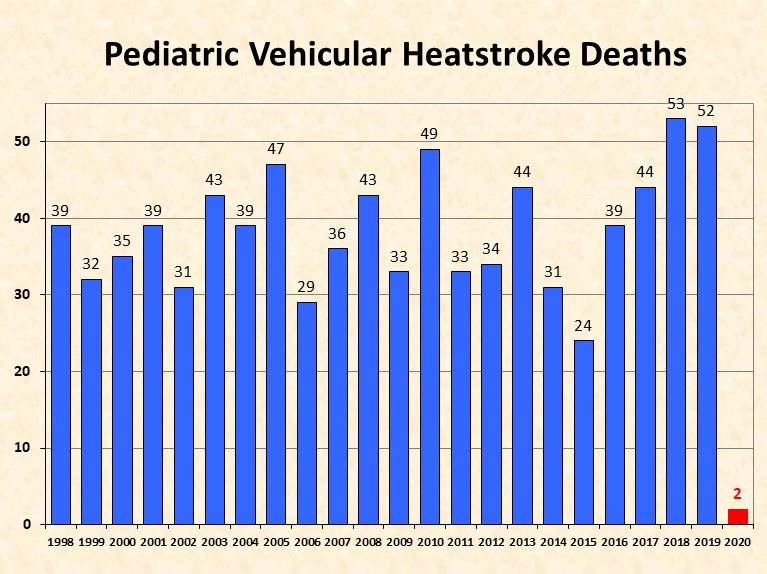It’s important to understand the dangers of children being left inside a car, even when it’s only 80 degrees outside.
We reached out to Certified Consulting Meteorologist Jan Null, who has been gathering data on pediatric vehicular heatstroke deaths since 1998 and documenting it on noheatstroke.org.
To understand how quickly the car becomes dangerous, you need to understand how the inside of your car heats up. The windows of your car are transparent and don’t absorb the sun’s rays that well, therefore they don’t actually warm up that much.
But have you ever worn shorts and sat down in your car on a warm, sunny day only to squirm or jump out seconds later because the seat is that hot? That’s because the seat, the steering wheel, and the dashboard—objects inside the car—all warm up considerably from the sun’s rays and can reach up to 200 degrees over time.
“Darker objects heat up more and faster than lighter-color objects,” Null adds. “But dark cars are not necessarily hotter than light cars – the discriminator between the two seems to be the interior color of the car.”
Once these objects inside the car are warmed, they give off heat themselves in the form of longwave radiation. They also heat the air inside the car by conduction, merely “touching” the air around the objects. Both of these mechanisms heat the air trapped inside the car efficiently and quickly.
“The closest analogy is a greenhouse–that’s the way greenhouses are designed,” Null explains. “The sides of the greenhouse and windows of a car are pretty much transparent to high-energy UV light from the sun. As the objects inside the greenhouse heat up, the heat given off by objects inside the greenhouse warm up the air inside the greenhouse.”
Even on an 80-degree day, it takes just 20 minutes for the interior air to reach 109 degrees and 45 minutes to reach 120 degrees. On a 90-degree day, it’s much quicker—it takes just 10 minutes to reach 109 degrees and 20 minutes to reach 119 degrees. Heating gets exponentially faster as the outside air temperature increases.

“You see a rapid initial increase [in interior temperatures] on cooler days just as on hot days,” Null says. “You don’t get to extreme temperatures as fast, but it still gets hot enough to be deadly.”
Two-thirds of the interior heating occurs in just the first 20 minutes, and cracking the windows only reduces the interior temperature by a negligible amount.
“Let’s take a relatively mild summer day in Southern California, an 80-degree day,” Null says. “The temperature inside the car after an hour will be on the order of 123 degrees. Cracking all four windows by two inches decreases the temperature by 2 or 3 degrees. 120 degrees is just as deadly as 123 degrees.”
What makes the interior of a car so dangerous for children is two-fold: there is no air circulation (even with the windows cracked) and a child’s regulatory system is not as efficient as an adult—a child’s body temperature warms 3 to 5 times faster than an adult.
“The smaller the child, the faster they can get into distress,” Null explains.
Heatstroke occurs once the core body temperature reaches 104 degrees and organs start shutting down at 107 degrees.
Not all children left in hot cars are left by accident; according to Null’s data, 54% were forgotten, 25% gained access to the car, 19% were knowingly left behind, and the remaining causes are unknown. If you think it could never happen to you, Null says think again.
“Have you ever missed your freeway off-ramp?” Null asks. “We have all these things going on while getting from point A to point B and people get distracted.”
Null suggests leaving a physical reminder in the car, such as a stuffed animal in the front seat, or put your brief case, wallet, purse, or phone in the back seat when your child is in the car.
“It’s one more reason to check your surroundings prior to locking up your car and walking away,” Null reasons. “Our manta is ‘look before you lock.”
Don’t forget your furry friends—dogs are particularly susceptible to heatstroke because they sweat very little through their paws and only cool down via panting, a very ineffective means of cooling.
“You look at the amount of surface area pets can sweat compared to the area a small child can sweat,” Null says. “Pets can conceivably get into distress even faster.”
Don’t forget a quarter of the cases occur when a child gains access to a car and can’t get out, either because they lock themselves in or child-safety locks on the rear doors.
“Always keep cars locked, keep remotes away from children, and teach them cars are not play areas,” Null suggests. “If a child is missing, check the pool first and then any cars in the area–those are the two places a child can die in a very short amount of time.”
As temperatures continue to rise this summer, be mindful of your littlest passengers to keep them safe and healthy.







